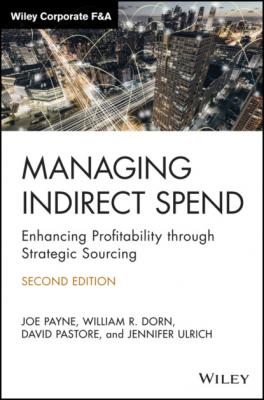Managing Indirect Spend. Joe Payne
Читать онлайн.| Название | Managing Indirect Spend |
|---|---|
| Автор произведения | Joe Payne |
| Жанр | Бухучет, налогообложение, аудит |
| Серия | |
| Издательство | Бухучет, налогообложение, аудит |
| Год выпуска | 0 |
| isbn | 9781119762362 |
267 269
268 271
269 272
270 273
271 274
272 275
273 276
274 277
275 278
276 279
277 280
278 281
279 282
280 283
281 284
282 285
283 286
284 287
285 288
286 289
287 290
288 291
289 292
290 293
291 294
292 295
293 296
294 297
295 298
296 299
Founded in 1807, John Wiley & Sons is the oldest independent publishing company in the United States. With offices in North America, Europe, Asia, and Australia, Wiley is globally committed to developing and marketing print and electronic products and services for our customers’ professional and personal knowledge and understanding.
The Wiley Corporate F&A series provides information, tools, and insights to corporate professionals responsible for issues affecting the profitability of their company, from accounting and finance to internal controls and performance management.
Managing Indirect Spend
Enhancing Profitability Through Strategic Sourcing
Second Edition
JOE PAYNE
WILLIAM R. DORN
DAVID PASTORE
JENNIFER ULRICH
Copyright © 2021 by John Wiley & Sons, Inc. All rights reserved.
Published by John Wiley & Sons, Inc., Hoboken, New Jersey.
Published simultaneously in Canada.
No part of this publication may be reproduced, stored in a retrieval system, or transmitted in any form or by any means, electronic, mechanical, photocopying, recording, scanning, or otherwise, except as permitted under Section 107 or 108 of the 1976 United States Copyright Act, without either the prior written permission of the Publisher, or authorization through payment of the appropriate per‐copy fee to the Copyright Clearance Center, Inc., 222 Rosewood Drive, Danvers, MA 01923, (978) 750‐8400, fax (978) 646‐8600, or on the Web at www.copyright.com. Requests to the Publisher for permission should be addressed to the Permissions Department, John Wiley & Sons, Inc., 111 River Street, Hoboken, NJ 07030, (201) 748‐6011, fax (201) 748‐6008, or online at www.wiley.com/go/permissions.
Limit of Liability/Disclaimer of Warranty: While the publisher and author have used their best efforts in preparing this book, they make no representations or warranties with respect to the accuracy or completeness of the contents of this book and specifically disclaim any implied warranties of merchantability or fitness for a particular purpose. No warranty may be created or extended by sales representatives or written sales materials. The advice and strategies contained herein may not be suitable for your situation. You should consult with a professional where appropriate. Neither the publisher nor author shall be liable for any loss of profit or any other commercial damages, including but not limited to special, incidental, consequential, or other damages.
For general information on our other products and services or for technical support, please contact our Customer Care Department within the United States at (800) 762‐2974, outside the United States at (317) 572‐3993, or fax (317) 572‐4002.
Wiley publishes in a variety of print and electronic formats and by print‐on‐demand. Some material included with standard print versions of this book may not be included in e‐books or in print‐on‐demand. If this book refers to media such as a CD or DVD that is not included in the version you purchased, you may download this material at http://booksupport.wiley.com. For more information about Wiley products, visit www.wiley.com.
Library of Congress Cataloging-in-Publication Data is Available:
ISBN 9781119762348(hardback)
ISBN 9781119762492(epdf)
ISBN 9781119762362(epub)
Cover Design: Wiley
Cover Image: © AerialPerspective Works/E+/Getty Images
Managing Indirect Spend is and always will be dedicated to Abraham Podolak and Steven Belli. Without your perseverance, vision, and enthusiasm, these pages would surely not have been written. Your joint leadership, guidance, and compassion built a unique company that changed all our lives forever.
Preface
WE WROTE THE FIRST EDITION of Managing Indirect Spend in 2010. At that time changes were happening in procurement, and many organizations were moving to centralized indirect spend and fully leveraging the aggregated purchasing power of their companies. Investments in procurement were high, with organizations adding people, processes, and technology to meet their objectives. Early in that decade, much was written about “Procurement 2020” and how far the function had come.
Still, not everyone got the memo. When we wrote the first version of this book, strategic sourcing and category management for indirect categories was still relatively new for many organizations. Now, organizations have teams of category managers, third‐party outsourcing, and comprehensive savings tracking. At the same time, they still have many of the same problems as they did in those early days. They lack spend visibility, they're seeing diminishing returns in terms of cost savings, they're having trouble driving change, and procurement is still perceived as a tactical, nonstrategic function.
The organizations that were in “build mode” earlier in the decade now need a seat at the table at the C‐level, they need investment in new systems that drive adoption and compliance with procurement policies through enablement, and they need training for their teams. They struggle, however, to create the business case for this investment. As Kurt Vonnegut wrote in his novel Hocus Pocus, “Another flaw in the human character is that everybody wants to build and nobody wants to do maintenance.”
Many large organizations—from publicly traded services companies without procurement departments, to large industrial manufacturers that allow each plant to purchase independently without leveraging volumes, or
